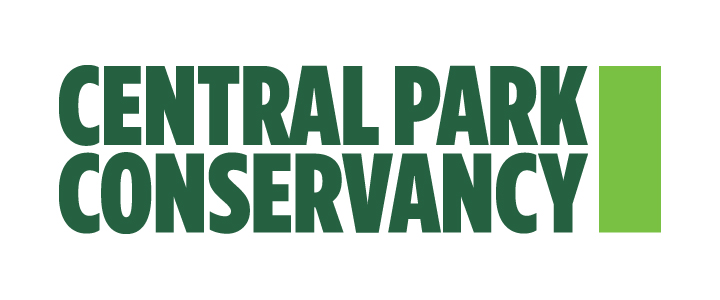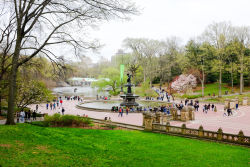Central Park
View all monuments in NYC Parks, as well as temporary public art installations on our NYC Public Art Map and Guide.
William Shakespeare
| Artist: | John Quincy Adams Ward |
| Dedicated: | April 23, 1872 |
| Location: | Literary Mall |
Artwork History
Who is this monument dedicated to?
William Shakespeare was born in Stratford-on-Avon in April 1564. His father, John Shakespeare, was a glove-maker and commodities trader who became a prominent local alderman and bailiff before suffering declining fortunes. His mother, Mary Arden, was the daughter of a prosperous landowner. Little is known of Shakespeare’s upbringing; he was locally schooled, likely at the King Edward VI School in Stratford, acquired a practical knowledge of Latin and Greek, and read the Roman dramatists.
In 1582, he married Anne Hathaway, and they had a daughter, Susanna, and twins Judith and Hamnet. Hamnet died in boyhood. The first account of Shakespeare’s professional accomplishments appears in 1592, when rival playwright Robert Greene, in his book A Groats-Worth of Witte, referred to the rising actor and dramatist as “an upstart crow, beautified with our feathers…” In 1594, Shakespeare was a charter member of a theatre company known as the Chamberlain’s Men (as of 1603, the King’s Men) who performed mainly at London’s Globe Theater. He held a one-tenth interest in the Globe, and many of his plays were performed there before it burned in 1613 during a production of his Henry VIII; Shakespeare retired to Stratford around this time.
Though he died in 1616, Shakespeare was enormously prolific. In his relatively short career, he authored 13 comedies, 13 historical dramas, 6 tragedies, 4 tragic comedies and 154 sonnets. Many of his plays have become classics, and his poems are revered for their mastery of language and verse. Thus, this modestly educated man of the Elizabethan age left an indelible mark on the English language and Western culture.
In addition to the sculpture, Central Park has other Shakespearean associations. In 1890, Eugene Schieffelin released 80 starlings into the park because they were mentioned in Shakespeare’s plays (as of 2021 there were over 150 million of them in America). In 1915, the Shakespeare Society assumed maintenance of a rock garden, built in 1912, near West 79th Street. In 1934, the Shakespeare Garden, which features plants named in the bard’s writings, was relocated to the hillside between Belvedere Castle and the Swedish Cottage. The Public Theater’s Shakespeare in the Park festival has been staged in Central Park since 1957.
How was this monument created?
In 1864, for the tricentennial of Shakespeare’s birth, a group of actors and theatre managers, including leading Shakespearean actor Edwin Booth (1833–1893), laid the cornerstone for this statue. Through a competition, the group selected John Quincy Adams Ward (1830-1910) in 1866 as sculptor. Later referred to as the “Dean of American Sculptors,” Ward would make nine sculptures for New York City’s parks.
The sculpture committee held several fund-raising benefits, including a performance of Julius Caesar. Jacob Wrey Mould (1825–1886), a principal designer of the structures and ornamentation within Central Park, designed the statue’s elaborate pedestal, sourced from Scotland. Ward combined a classical pose with many details of Elizabethan dress, and he relied on numerous images of Shakespeare, especially a bust in Stratford. The sculpture was cast in Philadelphia in 1870 at the Robert Wood & Co. foundry. It was unveiled in 1872, first on a temporary base. Some commentators found the work a noble effigy, while others derided it as a costume piece.
In 1986 a replica was cast for the Carolyn Blount Theater in Montgomery, Alabama, home to the Alabama Shakespeare Festival, and Montgomery benefactor Winton M. Blount established a maintenance endowment for the original. The Central Park Conservancy conserved the sculpture in 1995.
Artwork Details
| Description: | Portrait statue on pedestal |
| Materials: | Bronze, Westerly granite, Rockport granite |
| Dimensions: | H: 17'11" W: 8' D: 8' |
| Donor: | Demar Barnes, Public subscription |
Please note, the NAME field includes a primary designation as well as alternate namingsoften in common or popular usage. The DEDICATED field refers to the most recent dedication, most often, butnot necessarily the original dedication date. If the monument did not have a formal dedication, the yearlisted reflects the date of installation.
For more information, please contact Art & Antiquities at (212) 360-8163.
Check out your park's Vital Signs
Clean & Safe
Green & Resilient
Empowered & Engaged Users
Share your feedback or learn more about how this park is part of a
Vital Park System

Know Before You Go
Anticipated Completion: Spring 2024
Anticipated Completion: Spring 2025

Contacts
Central Park Information: (212) 310-6600
Central Park Information (for the Hearing Impaired): (800) 281-5722
Belvedere Castle, The Henry Luce Nature Observatory: (212) 772-0210
The Charles A. Dana Discovery Center: (212) 860-1370
The Dairy Visitor Center and Gift Shop: (212) 794-6564
North Meadow Recreation Center: (212) 348-4867
Loeb Boathouse (Bike rentals, boat rentals & gondolas): (212) 517-2233
Carousel: (212) 879-0244
Fishing at Harlem Meer (Catch & Release): (212) 860-1370
Harlem Meer Performance Festival: (212) 860-1370
Horseback Riding - Claremont Stables: (212) 724-5100
Metropolitan Opera (Performances on the Great Lawn): (212) 362-6000
New York Philharmonic (Performances on the Great Lawn): (212) 875-5709
Shakespeare in the Park - The Public Theater at the Delacorte Theater: (212) 539-8655
Central Park SummerStage: (212) 360-2777
Swedish Cottage Marionette Theater: (212) 988-9093
Tennis: (212) 280-0205
Weddings, Ceremonies and Photography at the Conservatory Garden: (212) 360-2766
Wildlife Center & Tisch Children's Zoo: (212) 439-6500












